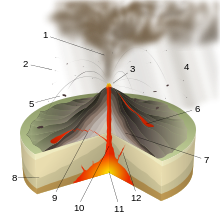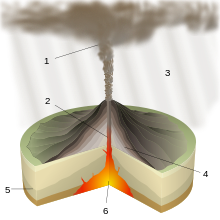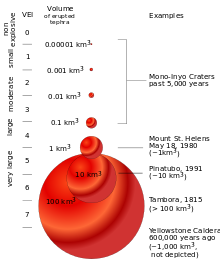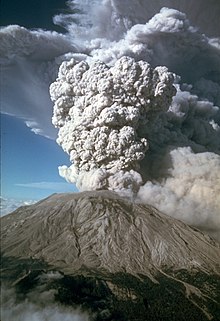Strombolian
 |
| An example of the lava arcs formed during Strombolian activity. This image is of Stromboli itself. |
Strombolian eruptions are similar to Hawaiian eruptions, but there are differences. Strombolian eruptions are noisier, produce no sustained eruptive columns, do not produce some volcanic products associated with Hawaiian volcanism (specifically Pele's tears and Pele's hair), and produce fewer molten lava flows (although the eruptive material does tend to form small rivulets).
- Parícutin, Mexico, which erupted from a fissure in a cornfield in 1943. Two years into its life, pyroclastic activity began to wane, and the outpouring of lava from its base became its primary mode of activity. Eruptions ceased in 1952, and the final height was 424 m (1,391 ft). This was the first time that scientists are able to observe the complete life cycle of a volcano.
- Mount Etna, Italy, which has displayed Strombolian activity in recent eruptions, for example in 1981, 1999, 2002-2003, and 2009.
- Mount Erebus in Antarctica, the southernmost active volcano in the world, having been observed erupting since 1972. Eruptive activity at Erebrus consists of frequent Strombolian activity.
- Stromboli itself. The namesake of the mild explosive activity that it possesses has been active throughout historical time; essentially continuous Strombolian eruptions, occasionally accompanied by lava flows, have been recorded at Stromboli for more than a millennium.
Vulcanian
 |
| Diagram of a Vulcanian eruption. (key: 1. Ash plume 2. Lapilli 3. Lava fountain 4. Volcanic ash rain 5. Volcanic bomb 6. Lava flow 7. Layers of lava and ash 8. Stratum 9. Sill 10. Magma conduit 11. Magma chamber 12. Dike) Vulcanian eruptions are a type of volcanic eruption, named after the volcano Vulcano, which also gives its name to the word Volcano.[17] It was named so following Giuseppe Mercalli's observations of its 1888-1890 eruptions.[18] In Vulcanian eruptions, highly viscous magma within the volcano make it difficult for vesiculate gases to escape. Similar to Strombolian eruptions, this leads to the buildup of high gas pressure, eventually popping the cap holding the magma down and resulting in an explosive eruption. However, unlike Strombolian eruptions, ejected lava fragments are not aerodynamical; this is due to the higher viscosity of Vulcanian magma and the greater incorporation of crystalline material broken off from the former cap. They are also more explosive than their Strombolian counterparts, with eruptive columns often reaching between 5 and 10 km (3 and 6 mi) high. Lastly, Vulcanian deposits are andesitic to dacitic rather than basaltic.[17] Initial Vulcanian activity is characterized by a series of short-lived explosions, lasting a few minutes to a few hours and typified by the ejection of volcanic bombs and blocks. These eruptions wear down the lava dome holding the magma down, and it disintegrates, leading to much more quiet and continuous eruptions. Thus an early sign of future Vulcanian activity is lava dome growth, and its collapse generates an outpouring of pyroclastic material down the volcano's slope.[17] |
| Tavurvur in Papua New Guinea erupting Deposits near the source vent consist of large volcanic blocks and bombs, with so-called "bread-crust bombs" being especially common. These deeply cracked volcanic chunks form when the exterior of ejected lava cools quickly into a glassy or fine-grained shell, but the inside continues to cool and vesiculate. The center of the fragment expands, cracking the exterior. However the bulk of Vulcanian deposits are fine grained ash. The ash is only moderately dispersed, and its abundance indicates a high degree of fragmentation, the result of high gas contents within the magma. In some cases these have been found to be the result of interaction with meteoric water, suggesting that Vulcanian eruptions are partially hydrovolcanic.[17] Plinian |
 |
| Diagram of a Plinian eruption. (key: 1. Ash plume 2. Magma conduit 3. Volcanic ash rain 4. Layers of lava and ash 5. Stratum 6. Magma chamber) Plinian eruptions (or Vesuvian) are a type of volcanic eruption, named for the historical AD 79 eruption of Mount Vesuvius that buried the Roman towns of Pompeii and Herculaneum, and specifically for its chronicler Pliny the Younger. The process powering Plinian eruptions starts in the magma chamber, where dissolved volatile gases are stored in the magma. The gases vesiculate and accumulate as they rise through the magma conduit. These bubbles agglutinate and once they reach a certain size (about 75% of the total volume of the magma conduit) they explode. The narrow confines of the conduit force the gases and associated magma up, forming an eruptive column. Eruption velocity is controlled by the gas contents of the column, and low-strength surface rocks commonly crack under the pressure of the eruption, forming a flared outgoing structure that pushes the gases even faster. These massive eruptive columns are the distinctive feature of a Plinian eruption, and reach up 2 to 45 km (1 to 28 mi) into the atmosphere. The densest part of the plume, directly above the volcano, is driven internally by gas expansion. As it reaches higher into the air the plume expands and becomes less dense, convection and thermal expansion of volcanic ash drive it even further up into the stratosphere. At the top of the plume, powerful prevailing winds drive the plume in a direction away from the volcano. |












